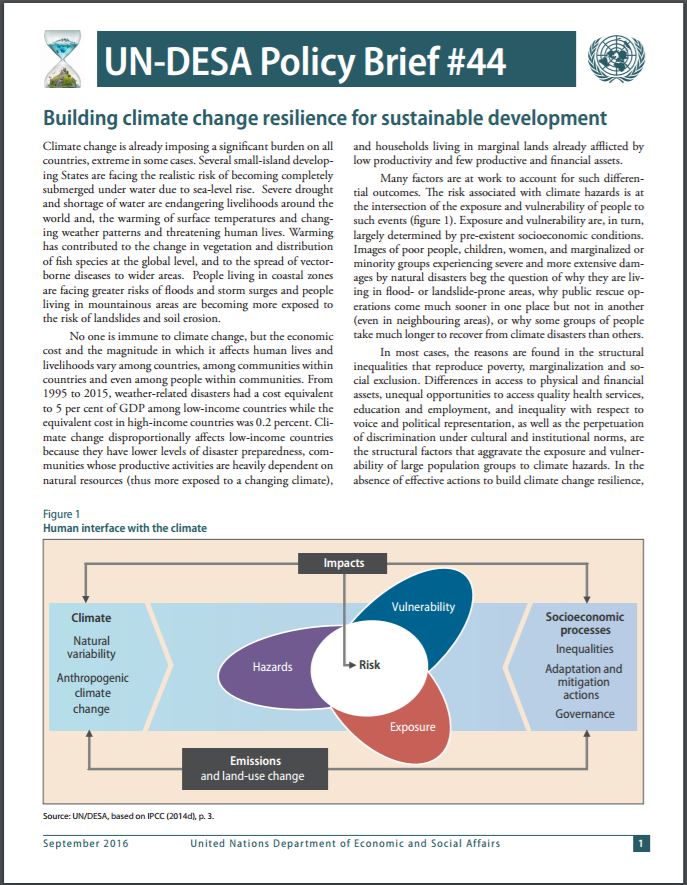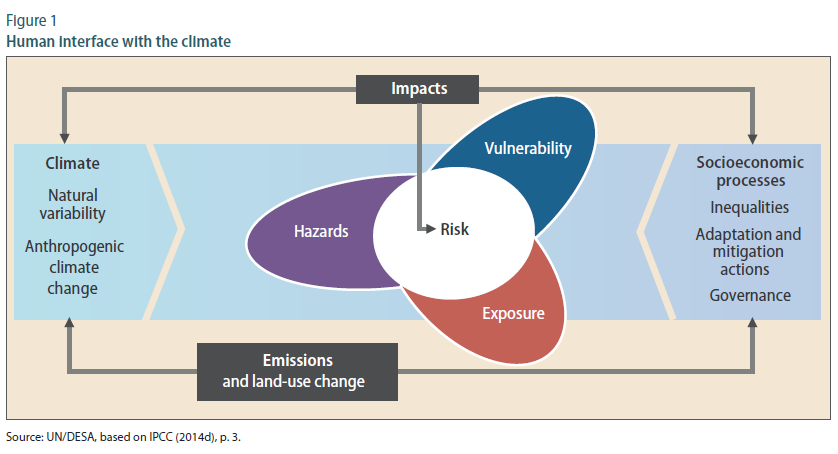
UN/DESA Policy Brief #44: Building climate change resilience for sustainable development
Climate change is already imposing a significant burden on all countries, extreme in some cases. Several small-island developing States are facing the realistic risk of becoming completely submerged under water due to sea-level rise. Severe drought and shortage of water are endangering livelihoods around the world and, the warming of surface temperatures and changing weather patterns and threatening human lives. Warming has contributed to the change in vegetation and distribution of fish species at the global level, and to the spread of vector-borne diseases to wider areas. People living in coastal zones are facing greater risks of floods and storm surges and people living in mountainous areas are becoming more exposed to the risk of landslides and soil erosion.
No one is immune to climate change, but the economic cost and the magnitude in which it affects human lives and livelihoods vary among countries, among communities within countries and even among people within communities. From 1995 to 2015, weather-related disasters had a cost equivalent to 5 per cent of GDP among low-income countries while the equivalent cost in high-income countries was 0.2 percent. Climate change disproportionally affects low-income countries because they have lower levels of disaster preparedness, communities whose productive activities are heavily dependent on natural resources (thus more exposed to a changing climate), and households living in marginal lands already afflicted by low productivity and few productive and financial assets.
Many factors are at work to account for such differential outcomes. The risk associated with climate hazards is at the intersection of the exposure and vulnerability of people to such events (figure 1). Exposure and vulnerability are, in turn, largely determined by pre-existent socioeconomic conditions. Images of poor people, children, women, and marginalized or minority groups experiencing severe and more extensive damages by natural disasters beg the question of why they are living in flood- or landslide-prone areas, why public rescue operations come much sooner in one place but not in another (even in neighbouring areas), or why some groups of people take much longer to recover from climate disasters than others.
In most cases, the reasons are found in the structural inequalities that reproduce poverty, marginalization and social exclusion. Differences in access to physical and financial assets, unequal opportunities to access quality health services, education and employment, and inequality with respect to voice and political representation, as well as the perpetuation of discrimination under cultural and institutional norms, are the structural factors that aggravate the exposure and vulnerability of large population groups to climate hazards. In the absence of effective actions to build climate change resilience, climate hazards are likely to slow-down long-term economic growth and reverse hard won development gains.
Transformative polices for climate change resilience
Building climate change resilience requires sound development policies aimed at closing the development gaps that leave some groups of people and communities disproportionately exposed to climate hazards. Addressing the root causes of vulnerability requires a continuum of policy interventions leading to the structural transformations that strengthen people’s opportunities and agency. Consistent policy interventions are required to provide:
- sound development policies focused on reducing inequalities for poverty eradication and social inclusion;
- immediate assistance in the wake of climate hazards and interventions for disaster risk reduction, for example, through early warning systems, creation of shelters and infrastructure improvements;
- policies for adaptation to a changing climate, entailing, for example, introduction of new crop varieties and water management techniques; and
- policies centred on ecosystem management and on income diversification.
These specific measures will be most effective in reducing climate change vulnerability when they are part of a broader development framework leading the way to the empowerment of today’s disadvantaged groups by improving their asset positions and access to input and product markets; by extending their access to quality basic services such as health, education and sanitation; and by changing the norms in order to expedite social and political inclusion.
Adoption of the 2030 Agenda for Sustainable Development, centred on the vision of "transforming our world", provides a unique opportunity to strengthen policymaking processes in such a way as to lead the way towards the transformations required for sustainable development, including building resilience in the face of a changing climate. Consistent with this global vision, the challenge going forward is in the implementation of national policies which, within each country context, will drive efforts towards poverty eradication, human development and climate resilience.

Follow Us